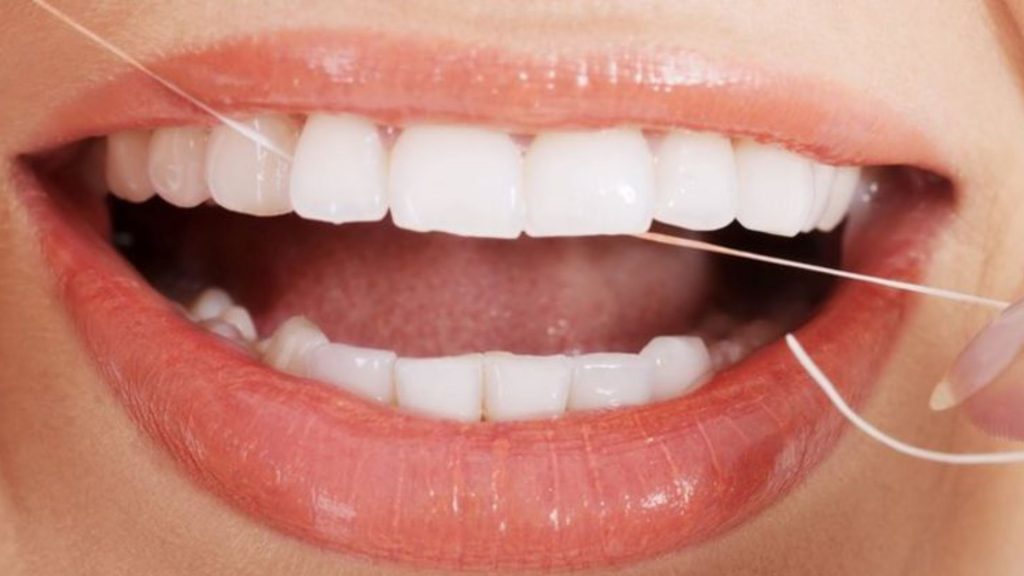“Tartar broke off while flossing” This line may startle you during your everyday oral hygiene regimen, but it emphasizes the significance of dental health. This article will discuss the importance of tartar building, the repercussions of its rapid detachment, and the actions you may take to avoid such unanticipated dental events. So, let’s look at how this apparently little event might offer important information about your dental health.
What Is Tartar?
Tartar is another term for tooth calculus. When you chew, leftover food bits don’t get cleaned up. Instead, they mix with germs and build up on the surface of your teeth as plaque. At first, these plates are not too hard. But if it stays in the mouth for a long time, where there are foreign salts in saliva and soft grit, it will harden. These hardened patches are called tartar, and they stick tightly to the surface of the tooth or where the tooth root meets the gums. Most of the time, people split tartar into two types based on how bad it is.
- Normal tartar: Light yellow and adheres to teeth.
- Serum tartar: Poor tartar removal causes irritation.
At this point, there will be mucus at the site of the infection, and even worse, it will start to bleed. These liquids rapidly infiltrate tartar and cannot be brushed off, turning it reddish brown.
Can Tartar Broke Off While Flossing?


Dental floss and brushing cannot eliminate tartar (mineralized plaque), a hard coating of bacteria and minerals. Dentists use special tools to remove tartar, which is bacteria and plaque hardened over time. However, if 2 criteria are satisfied, tartar may break off from the tooth:
String Dental Floss
Only string dental floss is capable of eliminating tartar from teeth. Even though water flossers can get rid of soft plaque and food stuck between teeth, they can’t get rid of hard tartar on the surface of teeth. The key difference between the two is in the tartar removal procedure. By using mechanical force, string dental floss may be used to floss and remove tartar from tooth surfaces. You may sometimes hook the thread beneath the tartar and remove it with your hand power.
However, this is only doable under the correct circumstances and with soft tartar. Despite its high water pressure, the water flosser cannot reach below the tartar and so cannot remove stubborn tartar. High-pressure water may eliminate mild plaque, to which tartar often attaches, but it cannot dissolve hard tartar.
Level Of Tartar
Dental floss is only useful in the early stages of tartar removal. Young tartar is much softer than mature stuff. It is critical to take advantage of this chance while the tartar is still soft and readily removed at home. Leaving tartar on your teeth will make it hard to remove at home, causing you to visit the dentist. Tartar that has hardened into a rock may only be removed by a dentist or a dental hygienist. Some telltale symptoms of tartar that is still in its early stages and easily eradicated by flossing:
Plaque And Stains On Teeth
When tartar develops in its early stages, plaque and white spots on teeth are generally the first indicators. Plaque is a soft film that forms on teeth and is made up of bacteria and bits of food. Plaque may show up after you eat or drink, and it may be white or clear. When plaque is not thoroughly removed by brushing and flossing, it may harden into tartar.
First, plaque creates white or light tartar. The tartar should be soft and easily removed using string dental floss and a toothbrush.
See below for an image of tartar in its early, manageable stages: 

Sense Of Tooth Roughness
If you feel like the surface of your teeth is not smooth, this means that plaque or tartar is building. If your teeth are plaque-covered and uneven, dental floss may remove it instantly. Use dental floss to remove plaque from teeth. But if the tartar has become hard or thick, normal dental floss may not be enough to get it all off.
After flossing, what should you do?


It is essential to keep your teeth clean and healthy after you have completed flossing to eliminate plaque and tartar. Look at the directions below to figure out what to do next:
Check The String Dental Floss
When you’re done cleaning your teeth with dental floss to get rid of tartar and plaque, it’s very important to check your method and how well it worked. We’ll show you how to check your floss after using it to make sure you got all the tartar off. First, examine the floss. If there are still food or grit particles on your floss, you know you’ve done a decent job flossing.
Finally, it may sound paradoxical, but you should smell the dental floss after using it. If the floss is clean, no tastes or odors will be left behind. If you detect a strong antibiotic aroma or if the stench goes away altogether, you’ve used the toothfloss correctly.
To Feel Clean, Gargle
After flossing or brushing, rinse your mouth with salt water to keep it clean. This removes bacteria and pollutants and refreshes. How to do this easy process:
First, get clean water that is either warm or cold, based on your taste, and pour it into a clean cup. You simply need 20ml to 30ml of water. Add a pinch of sea salt to the cup’s water. Sea salt is antimicrobial and cleans.
Next, gently rinse your mouth with salt water for 30–60 seconds. Salt water should be passed through the crevices between your teeth and gums. After carefully washing, spit away the salt water without adding clean water.
Repeat after meals or when your mouth needs further cleansing. Rinsing your mouth with salt water reduces germs and keeps it clean naturally.
Carefully Brush Teeth
Daily oral hygiene includes meticulous brushing after flossing. This guarantees that flossing removes all plaque and impurities. How to wash teeth carefully and effectively:
Prepare a soft, clean toothbrush and fluoride toothpaste to preserve dental enamel.
Then, rinse your mouth with clean water to eliminate plaque and liquid pollutants. Apply a little toothpaste on the toothbrush and handle it appropriately. Place the toothbrush perpendicular to the tooth surface and tilt it 45 degrees from the gums to the brush. Brush from the top down or bottom up, turning around each tooth’s axis, and brush the front, rear, and cut surfaces.
After flossing between teeth, rinse the toothbrush with clean water. Avoid gum and tooth enamel damage by brushing lightly instead of hard.
What to Remember After Scaling Teeth?
To keep tartar from returning after you’ve scaled your teeth or flossed them away, good oral hygiene and continuing to take care of your teeth are essential. Some examples of notes to take after tooth scaling can be found below:
Avoid These Foods After Tartar Removal
Not eating or drinking anything right after dental cleaning your teeth will help you avoid pain.
For example, this keeps the teeth and newly removed enamel from taking hard hits. Eating foods that are high in sugar and carbs can hurt your teeth and gingival health. Cutting back on sweets, fizzy drinks, and other sweet foods after tartar removal helps keep plaque from building up and protects tooth enamel.
Strongly acidic meals, such as sour fruits like grapefruit, oranges, lemons, coffee, and alcoholic or vinegar-containing drinks, can destroy tooth enamel and ruin your teeth. To protect teeth enamel and keep your mouth healthy, limit how much of these foods you eat.
Careful Dental Hygiene After Tartar Removal
After cleaning, taking care of your mouth is an important part of protecting and keeping your teeth healthy. There are certain critical actions you should take, according to dental experts:
- Brush your teeth at least 2-3 times a day, preferably after each meal, to get rid of grit and leftover food.
- Carefully brush your teeth in a circle from the incisors to the molars, then inside. To prevent hurting your gums and tooth enamel, use a toothbrush with soft bristles.
- Instead of toothpicks, use dental floss to remove food particles lodged between teeth. This aids in the prevention of tartar development.
- To keep your oral cavity clean and minimize hazardous microorganisms, rinse with salt water or specialist mouthwash.
- Maintain a regular dental visit with your dentist every 3-6 months. The dentist will examine your teeth, clear the tartar, and advise you on how to best safeguard your teeth.
You may maintain excellent dental health and safeguard your teeth after scaling by following these steps, keeping your smile bright and confident.
Is There A Trustworthy Dental Clinic In Perth?
As you can see, it may be difficult to avoid tartar buildup and maintain clean teeth. Tartar may be removed by flossing and brushing, but only if done incorrectly. When was the last time you saw the dentist? Have up with your regular dental check-ups at the Spring Orchid Clinic so you may have that beautiful smile on your face at all times. One of the greatest strategies to maintain a healthy mouth free of tartar is to get frequent dental checkups. Make an appointment right now to maintain your health and happiness. We’re excited to work with you and your loved ones to ensure a lifetime of healthy smiles.
FAQs
Can Tartar Fall Off On Its Own?
No, it isn’t. Many wonder whether tartar may be permanently removed if they only wait long enough. In contrast to common plaque, tartar has distinct characteristics. Unlike plaque, tartar is hard and sticks to the teeth, making it difficult to remove using a toothbrush, mouthwash, dental floss, etc.
In addition, tartar cannot be eliminated entirely by brushing your teeth. The dentist needs tools for tartar removal to ensure patient safety and optimal results.
What Does Tartar Look Like When It Breaks Off?
If your teeth aren’t clean, a brown, dull yellow, or black graft may indicate tartar. Food, water, and cigarettes affect its hue. Visit your dentist immediately if you feel your tooth is fractured or damaged. Maintaining your health and smile requires regular dental examinations.
What Breaks Down Tartar Quickly?
Dental calculus, often known as tartar, is mineral plaque that is securely bonded to tooth enamel and is sometimes difficult to remove with home therapy. A professional technique done by a dentist is the greatest choice for properly removing tartar. To eliminate tartar and brighten the enamel surface, the dentist will utilize specialized tools and equipment. Ultrasound and laser are 2 more innovative technologies for removing tartar rapidly and efficiently.
Maintaining a regular home dental care program, on the other hand, is essential for preventing tartar accumulation. Brush your teeth thoroughly, use dental floss to eliminate plaque, and limit your intake of sugary and acidic meals and beverages.





